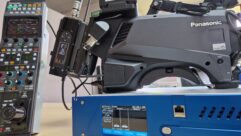Comfort AND Control
Aug 1, 2003 12:00 PM,
Marcus Buick
The short version is this: Jack, who lives in Oklahoma, had a neighbor across the street called Richard. After Jack and Richard became friends, Jack had a chance to experience his neighbor’s impressive home theater. Awestruck by Richard’s setup, Jack decided that he absolutely had to get his own.
Coincidentally, Richard happened to be the president and founder of Contemporary Sounds, a residential systems design and installation company. The company has been around since 1974 and has been putting in home-theater setups since 1985, back when the Fosgate Research Model 101A Tate II was all the rage. Jack was in the process of building a new 10,000-square-foot home in Oklahoma City, and there was plenty of extra space. A partnership was born.
Jack wasn’t sold on the idea from the beginning, but a finely detailed, well-tuned home-theater presentation space tends to sell itself. However, Richard’s attention to personal service sealed the deal. “Richard brought me in to listen to speakers and to look at projectors and screens, and I didn’t know what anything was,” Jack says. “He wouldn’t tell me. He just said, ‘Pick which ones you like best.’” As shown by Richard’s attention to service, a contractor’s active interest in customer opinion is essential, especially for residential installs.
FROM ATTIC TO HOME THEATER
Jack’s home theater/presentation facility/gaming room lives in an approximately 20-by-15-foot space with an interior designed by Linda Amen of Amen Interiors, located in Edmond, Oklahoma. Jack’s wife worked with Linda and Richard on the design from the front door all the way to the theater. According to Amen, they wanted it to be “comfortable the entire way.” Linda says that the unusual dimensions of the room forced her to augment her normal design approach. She also worked closely with Richard to upholster the acoustic room treatment at the front and rear of the theater. Overall, Linda was satisfied with the collaborative process. “It was very much a team effort,” she says.
The theater room is one floor above a five-car garage and is essentially attic space. There were concerns that rumble and vibration caused by cars coming and going would be an issue. Richard also worried that the noise of the electric garage-door opener would be audible during opening and closing. As it turned out, adding a thin layer of insulation to the garage ceiling smothered the sound of the opener, and car traffic turned out to be a nonissue.
Another potential problem was the hollowness of the garage. Having a large empty space underneath the theater might have caused imperfect resonances, like when extreme subsonic low end results in severe sonic reality through bone conduction, standing waves, and so on. However, in the case of this particular install, solid architecture and construction eliminated possible acoustic anomalies.
The primary control system throughout the estate is an AMX NSX IME. The system provides sound control for no less than nine zones using distributed audio. Controlled zones include the home theater, the family room, the main living area, the kitchen, the study, the back porch, the pool area, the master bedroom, and the master bath.
“The theater is really for the kids,” says Jack, whose children are allowed to bring friends, have sleep-overs, eat popcorn, drink sodas — all the normal things people would want to do in their own home theater. “Everything is [treated with] Scotchguard.” Jack’s primary reason for having a home theater is to provide a safe and controlled environment for the neighboring kids, whether they’re watching movies, listening to music, or playing video games. Jack enjoys the theater himself, but he draws the line at certain video games. “I don’t do surround gaming,” he says. “I get motion sickness.”
BANG FOR THE BUCK
One of the main objectives of the project was to keep costs down. The components of the theater, the projector, and the surround system were all inexpensive as far as high-end home-theater components are considered. However, Richard was careful not to sacrifice quality for the sake of frugality. The products he chose were all low end in cost but high end in value.
The Marantz VP12S1 DLP is a digital light processing projector that includes circuit board-based Faroudja digital video-processing circuitry known as directional correlation deinterlacing. This prevents or at least acknowledges the chroma upsampling frequency error that many digital projectors/HDTV and DVD-based media systems experience.
The VP12S1 provides a high-definition 1,280-by-720-pixel resolution, a 1,200:1 contrast ratio, 700 ANSI lumens brightness, progressive scan output, and the ability to display 480p or 720p progressive scan outputs from DVD, HDTV, and XGA, as well as being able to upconvert from NTSC, 480i, and 1,080i images. The I/O connections on the VP12S1 include HD component video, regular component video, S-video, and composite video. Analog RGB and IEEE 1394 inputs are also present.
The 7.1-surround system is composed of Miller and Kreisel (M&K) 150THX-series components. M&K has been designing satellite systems, components, and subwoofers for more than two decades. This surround setup is part of its THX Ultra series. In the past couple of years, Lucasfilm/THX has started certifying home-theater installations to have the same specifications as the larger THX-approved movie houses.
The M&K 150-series cabinets installed in Jack’s theater include an S-150 front pair, the S-150C or S-150AC center channel, SS-150 surround channels, and the MX-150 subwoofer. The mounting hardware M&K provides can be applied to third-party hardware from other speaker manufacturers. In many high-end surround setups, it would be easy to spend $5,000 on cabling alone. The M&K 150 series is hard to pass up if budget constraints are necessary. In Jack’s case, he couldn’t afford to.
The projection screen is a Stewart Filmscreen 54-by-96-inch fixed unit component. The screen is 16:9 capable with a 1,280-by-780 resolution capacity. It is the primary viewing surface in the theater. Plasma monitor and LCD touch screens are available for external theater viewing purposes. The AMX system speaks directly with the previously installed Vantage lighting control system through RS-232.
While the main screen is fixed, infrared commands open and close the green velvet drape assembly, which is controlled by the wireless AMX remote. Interface panels exist on the walls of the theater to accommodate external inputs such as VGA/XGA, PowerPoint presentations, and other external computer based sources, gaming inputs (for controllers of Microsoft’s Xbox and Sony’s PlayStation 2), and separate A/V inputs. Other panels exist with LCD directory with push-button access for wired manual control operations.
A handheld AMX wireless touch-screen remote (available in either 4-inch or 6-inch screen versions) is the primary and only wireless remote in the theater. AMX’s wired version of the same thing is the Modero touch panel, which comes in three sizes: 17, 15, and 12 inches. Only the 17-inch model comes standard with a 16:9 aspect ratio. The large viewing area accommodates multiple control options simultaneously. It has a 160-degree viewing angle and can display 16 million colors. All Modero touch panels are 4:3 capable.
In Jack’s machine rooms (two closets), two separate rack cabinets house the mass of noisy, machine-based components and computer hardware, including a Pioneer VSX-49 receiver and Elite DVD player, DTS amplifiers, and an RCA high-definition satellite receiver. Basically, heat, fans, and noise are all located well away from the acoustic enjoyment of the home-theater system. In fact, if you leave the theater, pass through the lobby, and walk down the hall, you’ll find them in a room off to the left.
ROOM TREATMENT
Every component-based system in a fixed acoustic space is held captive by the acoustic signature of that space. Reverb timing, spectral diffusion, and psychoacoustic values must all be considered when addressing the spatial volume and reproduction quality of any venue. That is especially true when accuracy is of primary importance and budget the main concern.
Acoustic Room Systems (ARS) was founded by Chris Kline and Frank Rose in 2001 as a spin-off of the fiberglass company Owens-Corning. The ARS room treatment is composed of plasterboard-styled gypsum/fiberglass diaphragmatic layers with variable attributes that are adjusted to comply with the style of mounting, the finishing, and the final aesthetic attributes desired. The reflective and absorptive layers of the treatment are approximately 1.25 inches thick and are typically built in to brand-new structures, as Jack did with his new house.
Most spun-fiber-based acoustic treatment absorb semieffectively down to 500 Hz. The ARS room treatment handles diaphragmatic absorption down to 120 Hz, according to Richard and ARS literature. This type of treatment is not only economically efficient but also has psychoacoustic implications. It also comes with approval from acoustic experts like Robert Harley. In the December 2002 issue of The Absolute Sound, Harley wrote that “comparing the identical system beforehand and after treatment, I was taken aback by the wholesale change in the sound. The best general description I can give is that the sound was more precise in every way: bass definition, dynamic articulation, special resolution, and tone color. The overall impression of control and clarity was startling.”
DECISIONS, DECISIONS
Why did Jack want his theater upstairs instead of in a more isolated environment like the basement? He said he had thought about that, but when he found out how high the water table from the local lake was in relation to the depth of his basement, he changed his mind. Even though the home is in tornado country, Jack felt more comfortable with the theater upstairs. He would prefer to put money into solid architecture and construction than play dice with chancy flood conditions. Decision making is tough when the voracity of nature is continually evident.
Decision making is also difficult in the world of high-end home theaters. New models and new specs are constantly coming out. Brand-new versions of the AMX Modero touch panel, the Marantz VP12S2, and the AMX NI series of controllers are all making their debut on the market. Your clients will always want bigger and better. Eventually, they’ll reach a threshold of satisfaction, and they’ll remain happy for a long time. Then their kids will come along to point out what’s bigger and better.
Marcus Buickis an engineer, a producer, and a writer. He can be reached at[email protected].
For More Information
AMX
www.amx.com
Ž 252
DTS
www.dtstech.com
Ž 253
Marantz
www.marantz.com
Ž 254
Miller and Kreisel
www.mksound.com
Ž 255
Pioneer Electronics
www.pioneerelectronics.com
Ž 256
RCA
www.rca.com
Ž 257
Stewart Filmscreen Corp.
www.stewartfilm.com
Ž 258
Vantage
www.vantageinc.com
Ž 259
Ž Circle this number on Reader Service Card or visit freeproductinfo.net/svc










